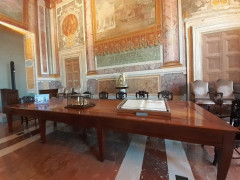The Lateran Palace becomes a Museum
This or similar were the headlines in the media. In truth, the former papal palace continues to be predominantly an ecclesiastical administrative building and, moreover, the endless rooms of the building erected by Pope Sixtus V have also been used as a museum since the 19th century. Now the existing museum has merely been redesigned. You can now only enter the rooms with a guided tour by religious sisters (Missionaries of Divine Revelation - green habit).
Basically, however, one only sees rooms with a certain amount of furnishings. Therefore, one cannot speak of an actual museum. Until the post-conciliar period, however, the Lateran Palace contained a real museum, namely the Museum Pio Cristiano with the early Christian sarcophagi and inscriptions, which had been set up by Giovanni Battista de Rossi. Enrico Josi and Umberto Fasola, both professors at the Pontifical Institute of Christian Archaeology, then helped move the objects to the expanded Vatican Museums.
This freed up the rooms for new purposes. Now, during the guided tour, you not only get an introduction to the history of the Lateran Palace, but you also see numerous rooms of the Beletage, where both the representation and private rooms of the popes were located. These rooms were still operational under Paul VI and some of them were furnished in the typical style of the 1960s with emphasised simplicity. Particularly impressive, of course, is the room in which the Lateran Treaties were signed on 11 February 1929, bringing the Vatican State into being (foto).
- Details
- Written by: Stefan Heid
- Category: Roman notes
 Römisches Institut der Görres-Gesellschaft
Römisches Institut der Görres-Gesellschaft







